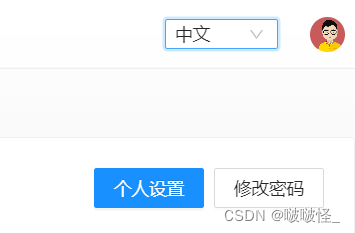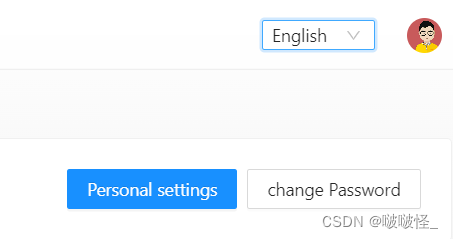在 React 中使用 i18next的示例
目录
1. 安装依赖
2. 在src下创建i18n文件夹
2.1 common下的zh-CN.js
2.2 common下的en-US.js
2.3 在common的index.js文件中引入
2.4 在resources.js中引入common模块的翻译
2.5 utils下初始化语言的方法
2.6 i18n.js代码如下
3. 在app.tsx中引入
4. 页面中使用
1. 安装依赖npm i i18next react-i18next i18next-browser-languagedetector
i18next 提供了翻译的基本能力。
react-i18next 是 i18next 的一个插件,用来降低 react 的使用成本。
i18next-browser-languagedetector 是用来检测浏览器语言的插件。
2. 在src下创建i18n文件夹
{
"common": {
"personSetting": "个人设置",
"modifyPassword": "修改密码",
"currentTime": '当前时间是 {{time}}',
}
}
2.2 common下的en-US.js
{
"common": {
"personSetting": "Personal settings",
"modifyPassword": "change Password",
"currentTime": 'Current time is {{time}}',
}
}
2.3 在common的index.js文件中引入
import en_common from './en-US/translation.json'
import zh_common from './zh-CN/translation.json'
export const langCommon = { en_common, zh_common }
2.4 在resources.js中引入common模块的翻译
import { langCommon } from './locales/common' //公共需要翻译的内容
// 把所有的翻译资源集合
const resources = {
en: {
translation: {
...langCommon.en_common
},
},
zh: {
translation: {
...langCommon.zh_common
},
}
}
export { resources }
2.5 utils下初始化语言的方法
export function initLangage() {
let lang = localStorage.getItem('language') || navigator.language // 获取浏览器的语言环境,兼容IE的写法
if (lang) {
lang = lang.substr(0, 2).toLowerCase() // 截取前两位字符,并转化为小写
return lang
} else {
return 'en'
}
}
2.6 i18n.js代码如下
import i18n from 'i18next'
import { initReactI18next } from 'react-i18next'
import LanguageDetector from 'i18next-browser-languagedetector';
import { resources } from '@/i18n/resources'
import { initLangage } from '@/utils'
i18n
// 检测用户当前使用的语言
// 文档: https://github.com/i18next/i18next-browser-languageDetector
.use(LanguageDetector)
// 注入 react-i18next 实例
.use(initReactI18next)
// 初始化 i18next
// 配置参数的文档: https://www.i18next.com/overview/configuration-options
.init({
resources, //资源初始化
lng: initLangage(),
interpolation: {
escapeValue: false, // react already safes from xss
},
react: {
useSuspense: false, // this will do the magic
},
debug: false,
})
export default i18n
3. 在app.tsx中引入
import './i18n/i18n'
4. 页面中使用
import { useTranslation } from 'react-i18next';
const SafetyManage: React.FC = (): React.ReactElement => {
const { t } = useTranslation();
return (
<div >
<Button
type="primary"
>
{t('common.personnalSetting')}
</Button>,
<Button
>
{t('common.modifyPassword')}
</Button>,
<p>
{t('common.currentTime', { time: dayjs().format('MM/DD/YYYY') })}
</p>
</div>
);
}
export default App;
useTranslation 返回的对象包含一个 t 方法,这个方法可以翻译文本。
i18next 提供了插值的用法: 在 t 函数中传递第二个参数,它是一个对象。


参考文章:https://www.zadmei.com/qdizjsjz.html
到此这篇关于在 React 中使用 i18next的文章就介绍到这了,更多相关React 使用 i18next内容请搜索软件开发网以前的文章或继续浏览下面的相关文章希望大家以后多多支持软件开发网!
相关文章
Yasmin
2021-05-01
Kita
2021-05-26
Faith
2023-07-21
Chipo
2023-07-21
Jacinthe
2023-07-22
Winona
2023-07-22
Ophelia
2023-07-22
Agnes
2023-07-22
Aurora
2023-07-22
Glory
2023-07-22
Pelagia
2023-07-22
Ianthe
2023-07-22
Nafisa
2023-07-22
Nora
2023-07-28
Rhea
2023-08-08
Kara
2023-08-08
Oria
2023-08-08
Nissa
2023-08-08